
About UsThe Numismatic Bibliomania Society is a non-profit organization promoting numismatic literature. For more information please see our web site at coinbooks.org SubscriptionsThose wishing to become new E-Sylum subscribers (or wishing to Unsubscribe) can go to the following web page link MembershipThere is a membership application available on the web site Membership Application To join, print the application and return it with your check to the address printed on the application. Membership is only $15 to addresses in the U.S., $20 for First Class mail, and $25 elsewhere. For those without web access, write to: David M. Sundman, Secretary/TreasurerNumismatic Bibliomania
Society AsylumFor Asylum mailing address changes and other membership questions, contact David at this email address: dsundman@LittletonCoin.com SubmissionsTo submit items for publication in The E-Sylum, just Reply to this message, or write to the Editor at this address: whomren@coinlibrary.com
BUY THE BOOK BEFORE THE COINYou won't regret it! |
- WAYNE'S WORDS: THE E-SYLUM AUGUST 30, 2009
- DAVID SKLOW MAIL BID SALE NO. 8 CLOSES OCTOBER 3, 2009.
- NEW BOOK: ONE HUNDRED YEARS OF SOLICITUDE
- SUMMER 2009 ISSUE OF THE C4 NEWSLETTER PUBLISHED
- PHENOMENONAL AND EXCEPTIONAL EXHIBITION ON TAP AT BELSKIE MUSEUM
- MORE ON THE FRENCH FIVE FRANCS OF NAPOLEON
- VOCABULARY ANSWER: BICENQUINQUAGENARY
- MORE ON DUTCH LION DOLLARS IN COLONIAL AMERICA
- WORLDWIDE COINS ARTICLE ON THE ROBOTS OF THE ROYAL AUSTRALIAN MINT
- MYSTERIOUS LEDGER SIX NINE FOUR: SILVER DOLLAR SMITH
- FEATURED WEB SITE: MEDALS OF THE WORLD
WAYNE'S WORDS: THE E-SYLUM AUGUST 30, 2009

Among our recent subscribers are Dwight L. Musser, courtesy of Neil Shafer, Randy Weir, John Conlin, Jean-Emmanuel Guillemain, and George H Koch. Welcome aboard! We now have 1,260 subscribers.
This week's issue is lighter than usual; I was traveling this week due to a death in the family. I apologize to readers who sent me submissions that I'm unable to get into this issue. Some of them may appear next week, but please bear with me as I try to get caught up. Thanks.
Wayne Homren
Numismatic Bibliomania Society
DAVID SKLOW MAIL BID SALE NO. 8 CLOSES OCTOBER 3, 2009.
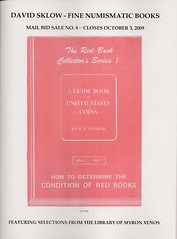 David Sklow - Fine Numismatic Books announces Sale #8, Saturday October 3, 2009, catalogs are in the mail, and it is also posted on my web site. finenumismaticbooks.com
David Sklow - Fine Numismatic Books announces Sale #8, Saturday October 3, 2009, catalogs are in the mail, and it is also posted on my web site. finenumismaticbooks.com
The sale includes: scarce and limited edition Red Books; long run of The Numismatist including original Volume #5, long run of deluxe Bowers & Merena catalogs, Rare 1910 work on Clearing House Loan certificates by James Cannon; runs of Bluestone, Hesslein, Elder, Kosoff, Charles Fisher, Ben Green catalogs; Complete bound set of the Numismatic Scrapbook;
Three volumes of British Historical medals by Laurence Brown; Several Mitchiner's on Jetons; numerous scarce periodicals; Deluxe leather Russian Silver Coinage by Julian; Set of Haxby's, Bound Coin Collectors Journal 1934-1945; Deluxe Bound Stack's catalogs; Rare 1962 First Printing of the 1804 Dollar Book by Bressett & Newman; Scarce ANA Convention Medal with 71 bar attachments 1893-1980, Complete set Empire Topics, Deluxe Numbered Full Leather Top 100 Morgan Dollar Varieties: The Vam Keys,
PH: (719) 302-5686, FAX: (719) 302-4933. EMAIL: numismaticbooks@aol.com. USPS: Box 6321, Colorado Springs, CO. 80934. Contact us for your numismatic literature needs!
NEW BOOK: ONE HUNDRED YEARS OF SOLICITUDE
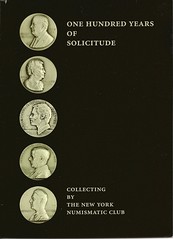 The new book One Hundred Years of Solicitude: Collecting by the New York Numismatic Club is a 45-page softcovered catalog of a recent exhibit by that name at the American Numismatic Society in New York. The work is not a history of the club, but rather an illustrated compilation of many interesting numismatic items collected by members of the NYNC.
The new book One Hundred Years of Solicitude: Collecting by the New York Numismatic Club is a 45-page softcovered catalog of a recent exhibit by that name at the American Numismatic Society in New York. The work is not a history of the club, but rather an illustrated compilation of many interesting numismatic items collected by members of the NYNC.
The book opens with a group of New York Numismatic Club medals, followed by sections on Ancient Greek Coinage. Roman Republican and Imperial coinage, and jewish and European coinages. Other sections cover coins and medals of the French and British pretenders. Several sections cover United States coins, tokens, and paper money. The final sections cover medals of the worlds.
Printed on glossy stock, the book's color illustrations are excellent. The book is well researched and written, as expected from any ANS publication. It's hard to pick a single favorite, but I enjoyed section XII: Bridge and Ferry Tokens.
John Kleeberg writes:
We have quite a few copies available. They can be obtained from our Secretary Treasurer, Constantin A. Marinescu, c/o Fortuna, 984 Madison Avenue, New York, NY 10075. The cost is $30 a copy, which includes postage and packing.
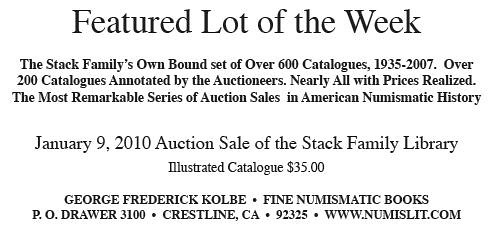
SUMMER 2009 ISSUE OF THE C4 NEWSLETTER PUBLISHED
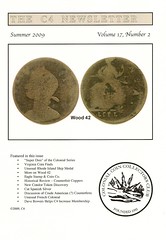 I always look forward to my copy of the C4 Newsletter, the official publication of the Colonial Coin Collector's Club. The Summer 2009 issue has a couple items of interest to numismatic bibliophiles.
I always look forward to my copy of the C4 Newsletter, the official publication of the Colonial Coin Collector's Club. The Summer 2009 issue has a couple items of interest to numismatic bibliophiles.
First, the is an article by Tom Kays titled Stray Finds - Historic Coins of Colonial Virginia
Ray Williams once lamented that numismatic authors, having written 90% of a book, take too long to finish that last 10% - delaying publication way too long to suit him. Here is a quick look at a slowly developing coin book that may lead to publication someday.
A fact surprising to the general public but something C4 readers know is that hundreds of old coins come to light each year found by lucky and persistent relic hunters, the quiet, successful ones - who now hold lifetime collections of dug objects amassed over half a century of happy digging. From these collections I've gathered data on one thousand early coins dug in old Virginia.
Surmises about coin origin, circulation and loss patterns by decade will be estimated in order to help reconstruct an extended true type set of circulating coins of Virginia.
Tom goes into a good bit of detail on his research to date. Good luck with the project - we'll eagerly await the book!
Also in this issue is an article titled Early Colonial Dealer by Daniel Sheffer. In the article Daniel discusses the significance of a 1917 fixed price list published by The Eagle Stamp & Coin. -Editor
Growing up I learned that my great grandfather, Earnest A. Hack, was a coin collector, turned dealer! He lived in Detroit, Mi just 20 miles from where I live. He began collecting in 1900, at the age of 11. In 1910 he opened a coin, currency and stamp shop.
PHENOMENONAL AND EXCEPTIONAL EXHIBITION ON TAP AT BELSKIE MUSEUM
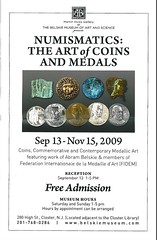 Numismatists, and certainly medal enthusiasts, will want to attend an exhibit in northern New Jersey coming September 13th through November 15th. There is an Opening Day Celebration on Sunday, September 13th with additional events planned for October and November.
Numismatists, and certainly medal enthusiasts, will want to attend an exhibit in northern New Jersey coming September 13th through November 15th. There is an Opening Day Celebration on Sunday, September 13th with additional events planned for October and November.
It will take place at the Belskie Museum in Closter, New Jersey, where your humble correspondent is curator of numismatics. (Thus the overzealous and hyperbolic headline above.) It will honor the museum's namesake, Abram Belskie with an exhibit of his prize-winning medallic art, plus a companion exhibit of contemporary medals by American medallists which have appeared or intend to appear in a FIDEM (Federation Internationaie de la Medaille d'Art) exhibition.
Closter is due west of the George Washington Bridge and was home, not only to sculptor Abram Belskie (1907-1988), but also sculptor Marcel Jovine (1921-2003), and somewhat lesser know medallist Joseph Di Lorenzo (1920-2001). In a previous generation it was also the site of the stone carving studio of Robert Alexander Bailley (1880-1961), so the area is well known for sculpture and medallic production.
On Belskie's death the local Lion's Club retrieved the contents of Belskie's studio --sculpture, plaster models, archives and all -- and built a museum in his honor. Thus the three truck-loads of his material ended up in a permanent building named in his honor.
In life, Abram would join a small group of Closter citizens for breakfast at a local restaurant each morning. Out of this friendship and loyalty grew the desire among these citizens, many of whom were members of the Lions Club, to perpetuate his memory. While the Lion's Club built the museum building, the city of Closter donated the land. It is adjacent to the city's Public Library.
I can imagine the camaraderie among the Closter citizens, and also the three medallists, Belskie, Jovine, and Di Lorenzo. Jovine even credits Di Lorenzo for introducing him to medal making. (All three were fellows of the National Sculpture Society, Jovine was even president for two years.) But in addition to the exchange of technology, sculptural tips, and joint trips to New York City, the three had great respect for each other. And perhaps would even lend each other a bag of plaster when a plaster model deadline came due the artist's supply ran out.
Plan to make the trip to Closter. Reception is from 1-5 pm Sunday, September 13 at the Belskie Museum, 280 High Street in Closter, NJ. For more information: www.belskiemuseum.com
If you can't make it that Sunday, plan to come any Saturday or Sunday 1-5 pm, or call for an appointment on another day.
THE BOOK BAZARRE
MORE ON THE FRENCH FIVE FRANCS OF NAPOLEON
Last week Granvyl Hulse asked:
Is there anyone in our E-Sylum group that is knowledgeable about French five francs of Napoleon?
Georges Sion writes:
I just joined the E-Sylum, and wanted to reply to Granvyl Hulse' query about his 5 Francs from Napoléon. Looking in the Le Franc reference book for this coinage, I found that 34,557 coins were actually struck (or, better, recorded) for AN 12 in the B (Rouen) mint.
The site http://www.lefranc.net records the known best specimen of every French modern coin.
Michel Prieur writes:
In our book LE FRANC it catalogs for 3000 Euros, roughly 4500 USD, in AU 58 condition (no better example seen). Of course, it is a very rare coin and it might go for more, or less, in an auction. We never had the opportunity to offer this coin in one of our auctions.
To read the previous E-Sylum article, see: QUERY: FRENCH FIVE FRANCS OF NAPOLEON (www.coinbooks.org/esylum_v12n34a09.html)
VOCABULARY ANSWER: BICENQUINQUAGENARY
Last week I asked:
Are there any medals for a bicenquinquagenary celebration? How many years does that mouthful of a word represent?
Ron Abler writes:
I suspect that "bicenquinquagenary" refers to a 250th anniversary. We all know that the "bicent-" portion refers to 200 years (as in bicentennial), and "quinquagenary" means 50 years and is synonymous with semicentennial or Golden Jubilee.
Another word for 250 years is "semiquincentennial," or half of five hundred years. While I am not personally aware of any bicenquinquagenary commemorative medals, I am confident that they exist. If not, I'll bet that our own U.S. Mint will issue one or more in 2026.
Marc C. Ricard writes:
I actually recognized the term "Bicenquinquagenary" from my other long-term passion; the world of classical music. In 1996, Princeton University celebrated their 250th or "Semiquincentennial" anniversary. The clever folks at Princeton decided to set themselves apart by using the term "Bicenquinquagenary" to name the celebration.
To commemorate the event, American composer and Princeton Professor of Music Emeritus Milton Babbitt wrote "Bicenquinquagenary Fanfare" for 2 Trumpets, Horn, Trombone, and Tuba. I'm not sure if the Fanfare replaced a medal as a lasting memorial, but I couldn't find any listings of medallic issues for that event in 1996.
Dick Johnson writes:
Decoding 'bicenquinquagenary' is easy. Two hundred years can be either "bicentennial" or "bicentenary." Break apart either one and insert in the middle the decade and the year:
Thus 'BICENQUINQUAGENARY becomes 'BICEN - QUIN - QUAG - ENARY.
BICEN - 200 years.
QUIN - 40 years.
QUAG - 5 years.
ENARY - anniversary.
Answer: 245th anniversary. It changes every year. The next year (246th) would be 'BICEN - QUIN - SEXT - ENARY.
This inquiry is very similar to one in a previous E-Sylum (vol 4, no 8. art 8 for February 18, 2001). This item contained the four responses your editor received from readers on the term QUASQUICENTENNIAL
I responded then:
Later I learned there are rules for these names. And that every year can have a word name (not just the major anniversaries). This was brought to my attention when reading Playboy (I look at the pictures in numismatic books, I read the text in the January 1975 issue of Playboy!) The year before our nation's 200th anniversary (Bicentennial, remember?) an author came up with the name for that year: the nation's 199th anniversary. I learned the formulae from this (and it works for any year).
For anyone interested I will email that Anniversary Name chart. But it will take some time to put that formulae into words (and find that old copy of Playboy). Contact: dick.johnson@snet.net
I received a half dozen requests when E-Sylum had 369 subscribers (1.63%). If I made the same offer today and that ratio still holds, would I receive 20.4 requests?
To read the earlier E-Sylum article, see: VOCABULARY ANSWER: QUASQUICENTENNIAL (www.coinbooks.org/esylum_v04n08a08.html)
Gar Travis pointed out one example of a 250th anniversary medal:
The British Museum, founded in 1753, has issued a medal to commemorate its 250th anniversary. Four internationally known contemporary British artists were invited to submit designs for the medal.
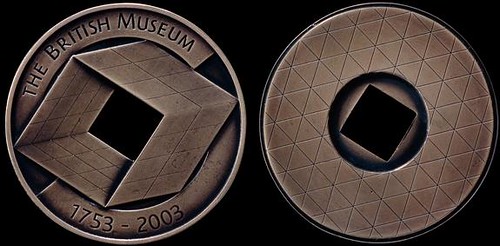
For more information, see:
The 250th Anniversary Medal
(www.britishmuseum.org/explore/online_tours/
museum_and_exhibition/the_250th_anniversary_medal/
the_250th_anniversary_medal.aspx)
MORE ON DUTCH LION DOLLARS IN COLONIAL AMERICA
Last week, Joe Lasser responded to the query, "Did the Spanish Really Mint Lion Dollars in Mexico?" Michael E. Marotta writes:
The easy answer is, "I don't know, either, but I, too, would like to see documented evidence." In the mean time, I point to indirect evidence from a nice picture book by John Porteous. In Coins (London: Octopus Books, 1973), illustration 125 on page 61 is of a Brabant Philippsdaalder, 1557.
The cutline says: "Silver from America, in the form of bullion or roughly made pieces of eight, flooded into Spain the sixteenth century; this wealth was mortgaged by Philip to pay for his foreign commitments, and much of it found its way into the Netherlands."
Popular books can be problematic sources, but according to the American Numismatic Society library, Porteous has to his credit these works:
- The Nature of Coinage, in Origin and History of Coinage, Martin Jessop Price, editor (1980)
- The Early Coinage of the Counts of Edessa, in Numismatic Chronicle. 7th series Vol. 15 (1975).
When the coin in question – a leuvendaalder dated 1643 – was struck, the Eighty Years War of Dutch independence from Spain was nearly over. Spain still had to pay for troops and supplies in the southern Netherlands. It would not be unreasonable for the Mexican mint to strike Dutch coins. But we will have to wait for direct documentary evidence from the Mint itself.
To read the earlier E-Sylum article, see: JOE LASSER ON DUTCH LION DOLLARS IN COLONIAL AMERICA (www.coinbooks.org/esylum_v12n34a12.html)
WORLDWIDE COINS ARTICLE ON THE ROBOTS OF THE ROYAL AUSTRALIAN MINT
Last week I wrote:
This week Computer World has an article that could be at home in Coin World. It's about new automation at the Royal Australian Mint.
Beth Deisher, Editor of COIN WORLD and WORLDWIDE COINS writes:
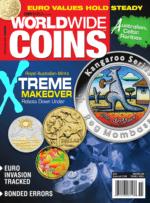 The cover story in our October/November issue of WorldWide Coins, which mailed Friday (Aug. 21) and is also available in the digital version online, tells all about the robots and changes at the Royal Australian Mint. The 8-page story includes lots of pictures showing the robots at work as well as the new materials handling system and renovations throughout the building. Also, there's a 2-page story about how the RAM makes those color coins using pad printing.
The cover story in our October/November issue of WorldWide Coins, which mailed Friday (Aug. 21) and is also available in the digital version online, tells all about the robots and changes at the Royal Australian Mint. The 8-page story includes lots of pictures showing the robots at work as well as the new materials handling system and renovations throughout the building. Also, there's a 2-page story about how the RAM makes those color coins using pad printing.
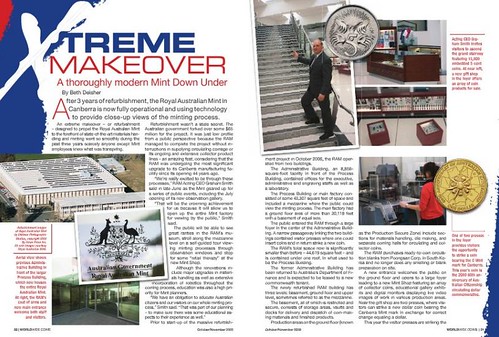
Beth adds:
RAM's technology is amazing. It was a fun story to do. I was in Australia last September/October and not all areas were complete at that time, but I spent a full day there (much of it wearing a hard-hat and steel-toed shoes) to be able to see the construction areas first-hand in order to understand what they would become upon completion. I did get to see most of the robots in operation.
The laser-guided AGVs are fun. If you step in front of one, it stops instantly and lights go off with a message blinking "human encounter...human encounter." This kind of detail didn't make the final version of the story -- we wanted to use as many pictures as possible to show the manufacturing aspects as well as the museum and gift shop areas. It was difficult to get this story into just eight pages! The pad printing process they use is also interesting ... we just couldn't leave out those colorful coins.
To read the earlier E-Sylum article, see: ROBOTS MAKING COINS AT THE ROYAL AUSTRALIAN MINT (www.coinbooks.org/esylum_v12n34a23.html)
THE BOOK BAZARRE
MYSTERIOUS LEDGER SIX NINE FOUR: SILVER DOLLAR SMITH
Another story concerns
"It was the idea of sinking silver dollar coins in the stone floor of his saloon that gained for this well known East Sider the name by which he is universally known."
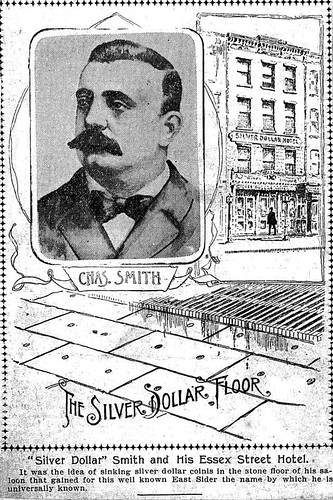
Chas. Smith is pictured inset, with an exterior elevation of his saloon including a sign "Silver Dollar Hotel"and a drawing showing the floor, with two coins embedded per rectangular tile. A little later in Ledger 694 we read:
NOTED NEW YORK EAST SIDE POLITICIAN DEAD
New York, December 22, - Charles Smith, better known as "Silver Dollar" Smith, for many years a prominent East Side politician died to-day at his home in this city.
Charles Smith was born in the 4th ward in 1851, and most of his life was spent in the immediate neighborhood of the place of his birth. His life was full of exciting episodes and interesting experiences. Smith practically grew up in the streets as a newspaper seller, messenger boy and vendor of fruits. The only respect in which he differed from other street gamins was in his thriftiness. Where the other youngsters wasted their money, Smith saved his and stored it away for future use. The dream of his youth was to own a saloon and become a power in the politics of the East Side. His enterprise and thrift made possible the realization of this ambition.
Few men whom the lower East Side has produced have wielded more power politically than did Smith. He established the Essex Street Saloon about the same time that he entered politics, and got his soubriquet by paving the floor of the saloon with silver dollars. He had coins of the same denomination worked into the gas fixtures and walls as well until it became impossible for a visitor to the saloon to look in any direction without seeing money. Smith was elected to the legislature in 1884…
We can only guess how many of those silver dollars gathered circa 1884 were of Seated Liberty design. Can E-Sylum readers suggest further examples of garish architecture/home decoration that one can visit today, daring visitors to look in any direction without seeing money?
To read the previous installment from ledger 694, see:
MYSTERIOUS LEDGER SIX NINE FOUR: MONEY TO BURN
(www.coinbooks.org/esylum_v12n34a19.html)
To read the earlier E-Sylum item about Silver Dollar Smith, see:
SILVER DOLLAR SMITH'S SALOON
(www.coinbooks.org/esylum_v12n29a27.html)
THE BOOK BAZARRE
FEATURED WEB SITE: MEDALS OF THE WORLD
This week's Featured Web site is Megan C. Robertson's Medals of the World.
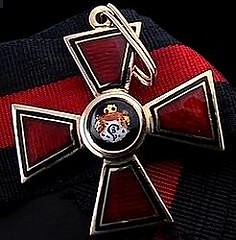
Here is a collection of images of medals from around the world.
www.medals.org.uk
